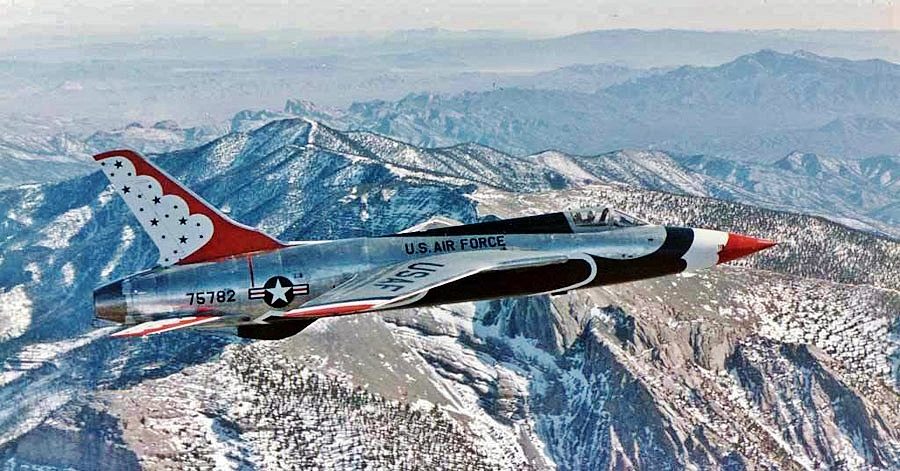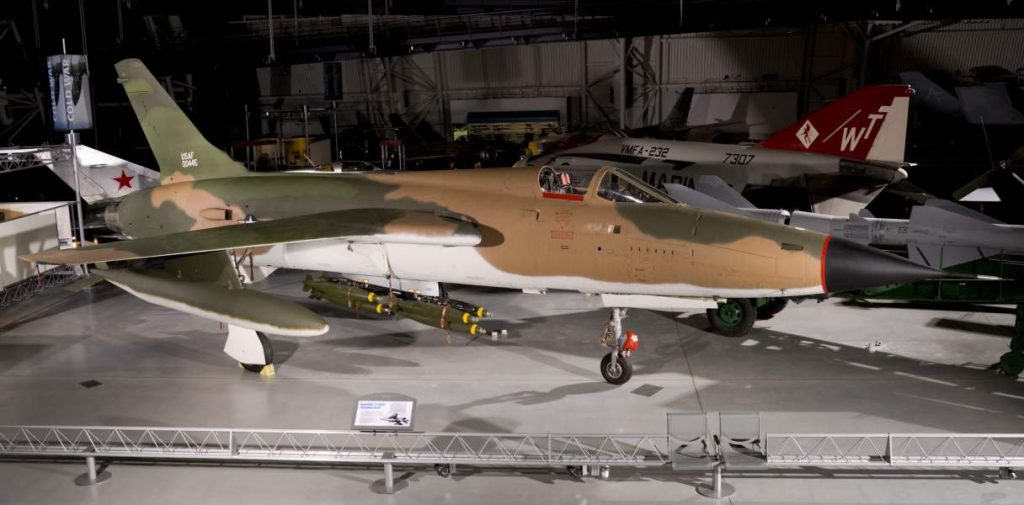The F-105 ‘Thud’ had quite an amazing career of dropping bombs and breaking cadet windows.
The best-laid military plans… often get changed!
Consider the B-52, built as a strategic nuclear weapons carrier, adapted to carpet bombing with conventional bombs. Similarly, the Air Force’s Republic F-105 Thunderchief was originally designed as a single-seat, supersonic fighter-bomber designed to deliver a single, internally mounted, nuclear weapon—a role, fortunately, for which it was never used.
The F-105, also known as the “Thud,” was a fighter-bomber capable of speeds up to Mach 2. While it never served in its intended nuclear role, it carried out the majority of strike bombing missions during the early years of the war in Vietnam. The “Thud” could deliver a heavier bomb load than the World War II Boeing B-17 Flying Fortress. Like other early Century Series fighters, such as the F-100, it was also armed with missiles and a cannon.

More than 20,000 Thunderchief sorties were flown over Vietnam. It was also the only combat aircraft pulled from combat due to high losses. Some 382 aircraft out of 833 were produced. As a low-altitude attack aircraft, it was not intended to be a fighter, and, although less agile than smaller MiG fighters, USAF F-105s were credited with 27.5 kills. Of these, 24.5 were shot down with cannon fire (one victory was shared with an F-4), and three with AIM-9 Sidewinder missiles. One F-105F is unofficially credited with downing three MiGs—one by air-to-air missile, the second by cannon fire, and the third by jettisoning the centerline rack full of bombs directly into the path of a surprised MiG.

A typical mission involved refueling at least once before reaching the target area and possible another refueling to make it back to base.
The F-105D/F variants were the first aircraft to be converted to a two-seat Wild Weasel configuration. The Wild Weasel specialized in electronic suppression of enemy air defenses, flying with and protecting F-4 fighter-bombers on strike missions. F-105 Wild Weasels remained in service until 1984, when they were replaced by F-5G Wild Weasels.
Note: The USAF used the F-105 for the Thunderbirds’ six airshows in 1964. After a structural failure of an F-105 during a practice session, the team switched back to the F-100.

Every good airplane deserves a good story. On 31 May 1968, a dedication ceremony took place at the United States Air Force Academy to honor graduates who had served in Vietnam. The ceremony included the entire cadet wing, the superintendent and commandant of cadets of the USAFA, a representative of Republic Aircraft, members of the press, among others. To conclude the ceremony, a flight of four F-105s were to fly over in formation at 1,000 feet and then fly over singly at 250 feet.
The formation portion was flown as planned. But the flight leader, Lt Col James “Black Matt” Matthews, came back for the single-file pass and exceeded the speed of sound at less than 100 feet. The ensuing sonic boom broke hundreds of windows. (Herts, Ray (1 June 1968). “Sonic Boom in Fly-Over Damages Academy Buildings” (scan). Colorado Springs Gazette-Telegraph. pp. 1,16.)
More than 100 F-105s are on display across the country in museums or parked or mounted on display. The National Museum of the United States Air Force at Wright-Patterson AFB has a beautiful example on display.

The F-105 was officially retired on 4 June 1983, accompanied by a flight of 24 aircraft flying over Hill AFB, Utah, in a Diamonds-on-Diamonds formation.


Re Thuds on display: If you’re anywhere near the FL Panhandle I can recommend the Air Force Armament Museum at Eglin AFB (near Destin, etc.) where they have a nicely displayed 105 inside, plus many other parked aircraft and weapons displays inside and out. See: http://www.afarmamentmuseum.com/
In June 1965, I was sent to Takhli Thailand to support the F-105 for the U.S. Air Force. During my one year tour, we had some F-105’s that didn’t return from their bombing mission.
I had the privilege of preparing one of the last New Jersey Air National Guard 105s to be sent to the Cradle of Aviation museum on Long Island. They flew it in from McGuire back to its “birthplace” at Fairchild Republic in Farmingdale N.Y.